Global Sensitive Toothpaste Market Size and Trends
Global sensitive toothpaste market is estimated to be valued at USD 1.86 Bn in 2025 and is expected to reach USD 2.74 Bn by 2032, exhibiting a compound annual growth rate (CAGR) of 5.7% from 2025 to 2032.
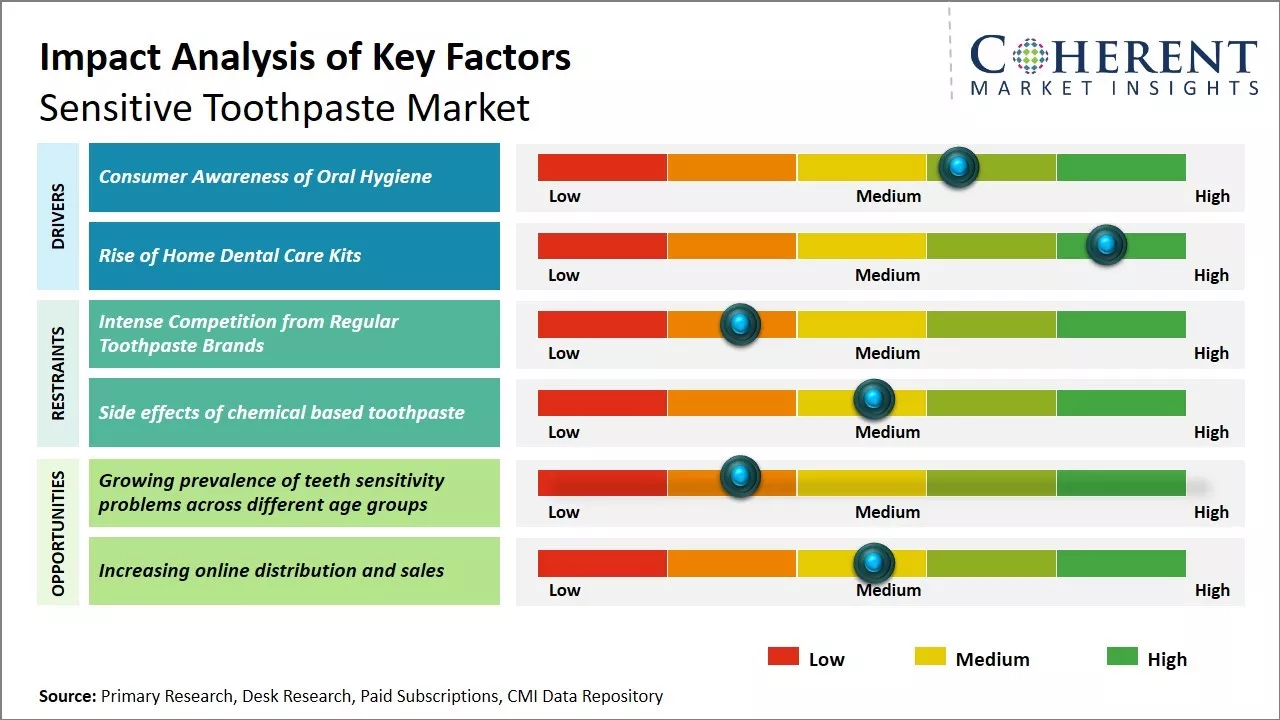
Discover market dynamics shaping the industry: Download Free Sample
Global sensitive toothpaste market has been witnessing growth steadily over the past few years. Rising awareness about oral healthcare and growing demand for toothpaste that contain ingredients to soothe gum issues and tooth sensitivity are expected to drive the market growth. Many leading toothpaste brands have introduced specialized products formulated with ingredients like potassium nitrate and sodium fluoride that provide relief from sensitivity. Increasing prevalence of dental problems caused by aging, poor dietary habits and other issues have further boosted its demand. Low pricing of sensitive toothpaste compared to other treatments is boosting its adoption.
Consumer Awareness of Oral Hygiene
In the past few years, there has been a significant rise in consumer awareness regarding oral health and hygiene. Dental issues are no longer considered superficial problems and more people now understand how critical good oral care is to overall health. Regular visits to the dentist have become a norm among urban populations. Education around risks of gum diseases and tooth decay have encouraged people to take oral health more seriously. Sensitivity has also emerged as an important concern for many as other dental problems are addressed. This increased focus on oral wellness is driving more people to specifically seek out toothpastes that promise relief from tooth sensitivity. Products with desensitizing ingredients are perceived as a suitable way to manage sensitivity issues. Manufacturers have capitalized on this growing demand by launching specialized toothpastes targeted towards sensitive teeth. Aggressive marketing campaigns highlight the role of these products in providing instant cooling relief. As long as oral health stays a consumer priority, the sensitive toothpaste category can benefit from sustained interest.
Market Concentration and Competitive Landscape
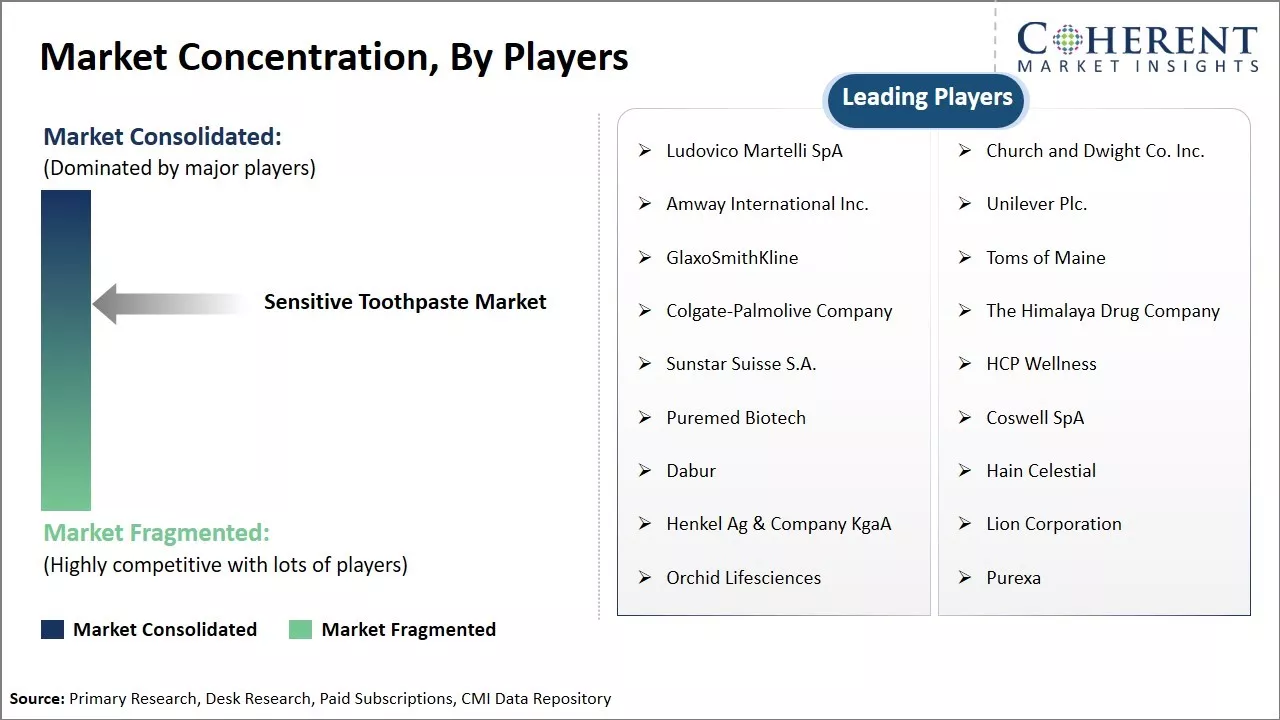
Get actionable strategies to beat competition: Download Free Sample
Rise of Home Dental Care KitsAlongside greater dentist visits, the past few years have witnessed a surge in at-home oral care solutions and dental treatment kits. Consumers are increasingly taking preventive measures and small dental procedures into their own hands rather than always relying on expensive professional treatment. Easy availability of teeth whitening Strips, water flossers, replacements for misplaced wires, and other such items have facilitated this shift towards self-care.All-in-one home kits that provide custom trays, desensitizing gels or other remedies allow symptom management in the comfort of one's home. Busy urban lifestyles encourage convenient do-it-yourself solutions. Manufacturers are designing affordable yet effective at-home treatments for sensitive teeth. This has emerged as a strong associated market for sensitive toothpastes, creating additional demand from shoppers seeking effective oral care without visiting the dentist each time.
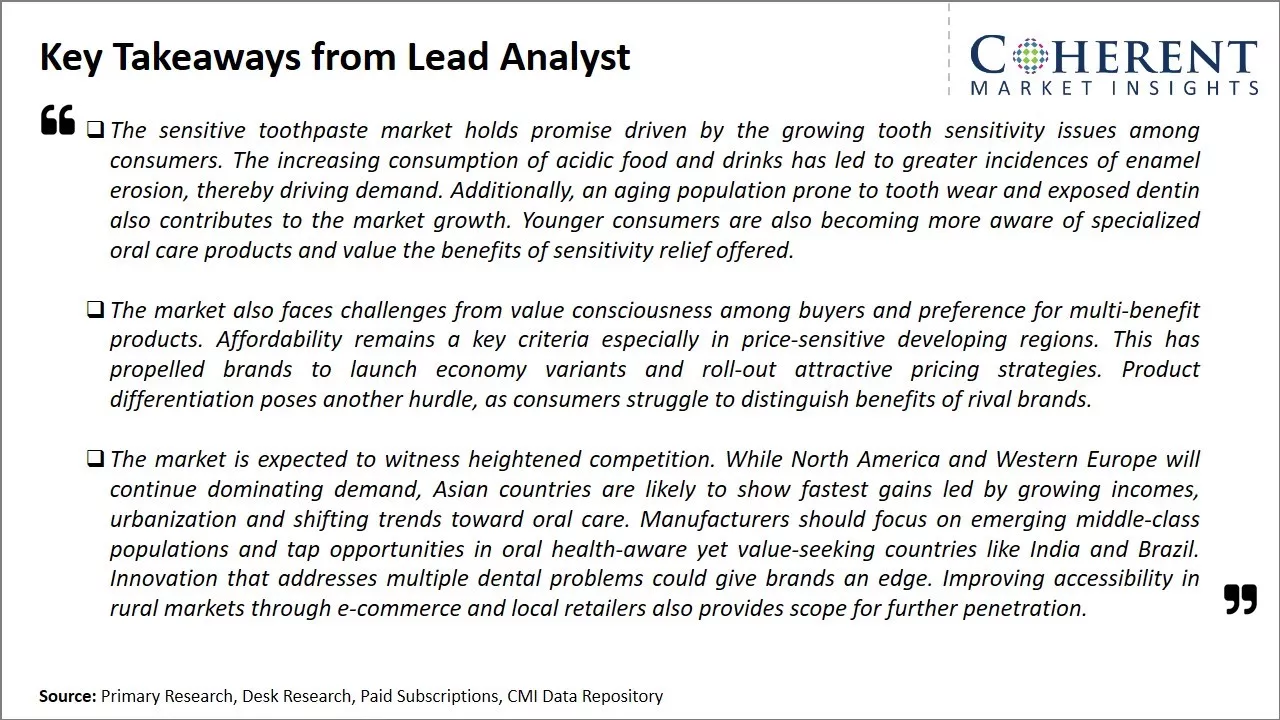
To learn more about this report, Download Free Sample
Market Challenges: Intense Competition from Regular Toothpaste BrandsOne of the key challenges faced by the sensitive toothpaste market is intense competition from regular toothpaste brands that are expanding their product lines to offer sensitive variants. Private label brands providing cheaper alternatives are also capturing market share. Manufacturers also have difficulties in changing consumer mindsets that associate tooth sensitivity issues with aging. This makes it hard to attract younger consumers. Increased raw material costs and pricing pressures from retailers pose further difficulties in maintaining profit margins.
Market Opportunities: Growing prevalence of teeth sensitivity problems across different age groups
Growing prevalence of teeth sensitivity problems across different age groups worldwide presents considerable opportunities for market growth. Rising numbers of people suffering from receding gums and acid erosion caused by dietary and lifestyle changes boost the potential for sales expansion. Innovations in desensitizing technologies allow manufacturers to position specialized products as premium offerings for price-conscious consumers as well.
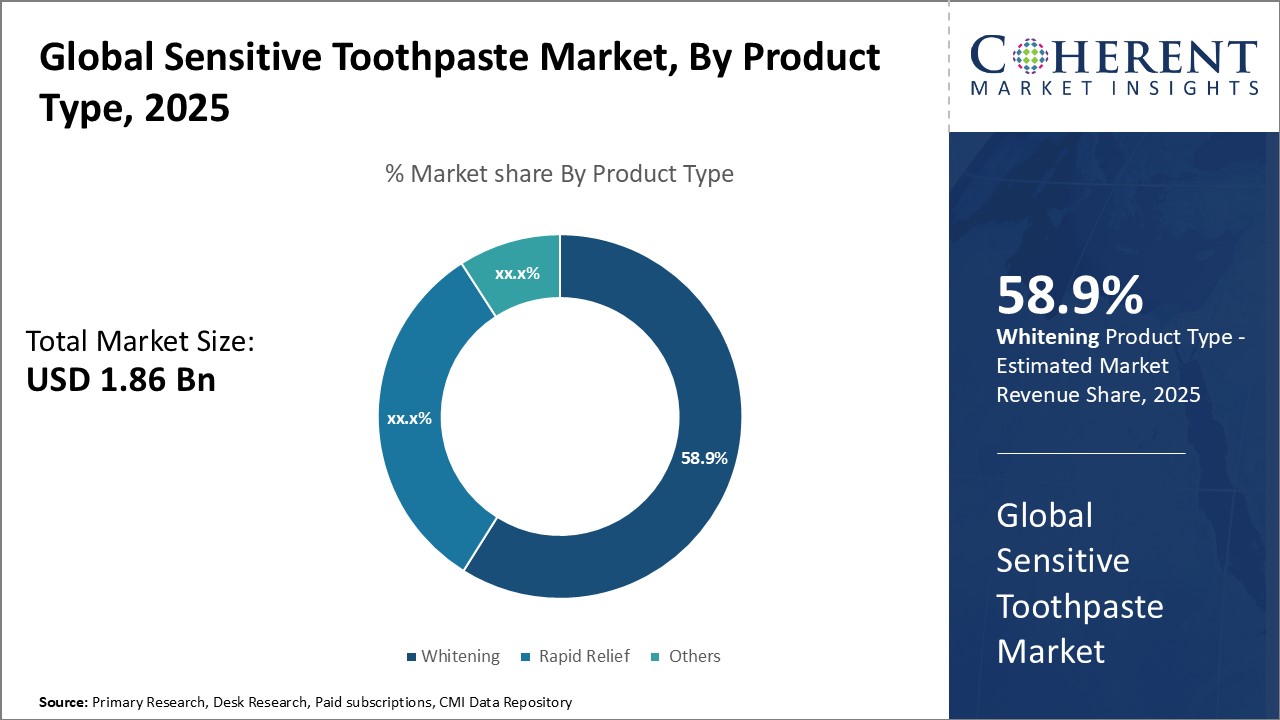
Discover high revenue pocket segments and roadmap to it: Download Free Sample
Insights, By Product Type: Focus on Aesthetics Drives Demand for Whitening ToothpastesWhitening segment is estimated to contribute 58.9% share of the sensitive toothpaste market in 2025, owing to consumers' increasing focus on aesthetics and appearance. Whitening toothpastes promise visibly whiter teeth with regular use, appealing to those concerned about smile esthetics. As society places greater emphasis on whitened, bright smiles, whitening toothpastes have grown in popularity. These products aim to gently remove surface stains from teeth through mild abrasives or bleaching agents like hydrogen peroxide or carbamide peroxide. Some feature whitening ingredients like calcium carbonate, hydrated silica, and sodium tripolyphosphate that help lift stains without harshly scrubbing enamel. Gentler formulations appeal to sensitive teeth owners worried about abrasion. Whitening toothpastes may also contain optical agents that temporarily enhance whiteness by scattering light off teeth surfaces. Social media plays a role too, as selfies and photos emphasize smiles. This influences product development – whitening toothpastes now come in varieties suited to different lifestyles, like 3-day express whitening for special occasions or charcoal toothpastes advertised as "detoxifying" for teeth and mouth. Whitening lines sometimes include take-home kits with custom trays and bleaching gels for faster results to satisfy image-conscious users.
Insights, By Distribution Channel: Supermarkets Dominate Sensitive Toothpaste Distribution
Among distribution channel, supermarkets /hypermarkets segment is estimated to hold 40.1% share due to their wide product selections, convenient locations and promotional discounts. Most consumers do their regular household shopping at superstore chains where people can easily pick up toothpaste alongside other grocery and healthcare essentials in one trip. Supermarkets dedicate significant shelf space to oral care aisles stocked with various toothpaste brands. Signage and displays showcase new products and deals while familiar store brand options offer good value. Weekly circulars and loyalty programs combine with impulse purchases to drive volumes. Strategic store layouts place toothpaste prominently at eye level as shoppers pass through for other items. This prime “endcap” placement, coupled with front-of-store promotions, primes customers to choose toothpaste even if unplanned. Online household shopping has grown but supermarkets still dominate due to habitual store loyalty and "one-stop shop" convenience. Most people see a dentist once or twice yearly while brushing teeth daily – this frequency makes supermarkets the default choice over pharmacies requiring separate trips. Their expertise lies more in acute conditions while preventative care focuses on maintaining oral hygiene through mainstream retail channels. Overall, supermarkets have optimized distribution and pricing strategies to cement their position as the preferred suppliers of routine dental products like sensitive toothpaste.
Regional Insights
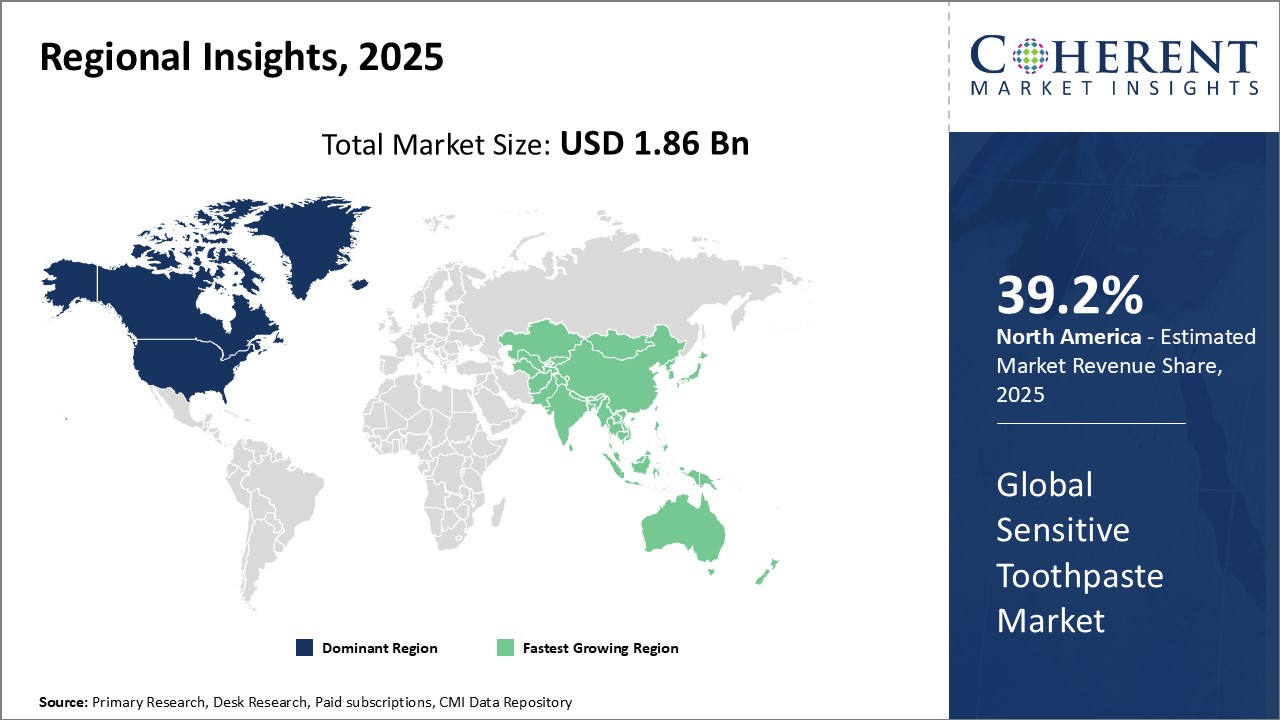
Need a Different Region or Segment? Download Free Sample
North America has dominated the global sensitive toothpaste market for several years owing to high consumer awareness and demand for oral healthcare products in the region with estimated 39.2% share in 2025. The U.S. accounts for the largest market with close to half of the total North American sales due to the presence of leading brands such as Sensodyne, Colgate Sensitive Pro-Relief, and Tom's of Maine in the country. Their wide availability across all distribution channels and extensive marketing campaigns to highlight the benefits of such products have driven volumes. Dental insurance coverage for a large population and focus on preventive oral care among dentists have encouraged people to opt for sensitive toothpaste over regular varieties.
Asia Pacific region has emerged as the fastest growing market for sensitive toothpaste in recent times. China is pioneering this growth due to a booming middle-class with increasing spending power and health consciousness. Significant exposure to dentist recommendations along with strong penetration of international brands entering into the Chinese market via e-commerce platforms are supporting the category expansion. India is another promising country expected to witness high double-digit growth during the forecast period due to evolving retail infrastructure across small towns and prioritization of dental care needs, especially among millennials. Furthermore, warming climate has exacerbated tooth sensitivity issues among Indian consumers, thereby, propelling product adoption.
Market Report Scope
Global Sensitive Toothpaste Market Report Coverage
| Report Coverage | Details | ||
|---|---|---|---|
| Base Year: | 2024 | Market Size in 2025: | USD 1.86 Bn |
| Historical Data for: | 2020 To 2024 | Forecast Period: | 2025 To 2032 |
| Forecast Period 2025 to 2032 CAGR: | 5.7% | 2032 Value Projection: | USD 2.74 Bn |
| Geographies covered: |
|
||
| Segments covered: |
|
||
| Companies covered: |
Ludovico Martelli SpA, Church and Dwight Co. Inc., Amway International Inc., Unilever Plc., GlaxoSmithKline, Toms of Maine, Colgate-Palmolive Company, The Himalaya Drug Company, Sunstar Suisse S.A., HCP Wellness, Puremed Biotech, Coswell SpA, Dabur, Hain Celestial, Henkel Ag & Company KgaA, Lion Corporation, Orchid Lifesciences, Purexa |
||
| Growth Drivers: |
|
||
| Restraints & Challenges: |
|
||
Uncover macros and micros vetted on 75+ parameters: Get instant access to report
Global Sensitive Toothpaste Industry News
- In March 2023, TePe launched a new line of toothpaste for patients with specific oral care requirements. The two new choices, TePe Daily and TePe Pure, have been specifically formulated to assist individuals with dry mouth and sensitive gums.
- In March 2022, Sensodyne launched a new range of toothpastes called Sensodyne Nourish to strengthen and protect sensitive teeth
- In April 2022, GSK Consumer Healthcare launched Sensodyne Nourish, a new range of toothpaste designed to fortify and nourish teeth with bio-active minerals for a healthy, sensitivity-free mouth
- In April 2022, Sensodyne partnered with design expert and Emmy-Nominated TV host, Bobby Berk, to launch new nourish toothpaste
*Definition: Sensitive toothpaste market consists of toothpastes formulated with specific ingredients to relieve dental sensitivity pain. These toothpastes contain desensitizing agents that coat and block the tiny tubes inside the tooth affected by sensitivity, reducing pain caused by temperature changes or pressure. These are designed for consumers suffering from sensitivity in their teeth caused by conditions like receding gums or cracked enamel. Sensitive toothpastes aim to provide relief from the sharp, painful sensations one feels from normally harmless stimuli on sensitive teeth.
Market Segmentation
- Product Type Insights (Revenue, USD Bn, 2020 - 2032)
- Whitening
- Rapid Relief
- Others
- Distribution Channel Insights (Revenue, USD Bn, 2020 - 2032)
- Supermarkets/ Hypermarkets
- Convenience Stores
- Pharmacies and Drug Stores
- Online
- Regional Insights (Revenue, USD Bn, 2020 - 2032)
- North America
- U.S.
- Canada
- Latin America
- Brazil
- Argentina
- Mexico
- Rest of Latin America
- Europe
- Germany
- U.K.
- Spain
- France
- Italy
- Russia
- Rest of Europe
- Asia Pacific
- China
- India
- Japan
- Australia
- South Korea
- ASEAN
- Rest of Asia Pacific
- Middle East & Africa
- GCC Countries
- Israel
- Rest of Middle East & Africa
- North America
- Key Players Insights
- Ludovico Martelli SpA
- Church and Dwight Co. Inc.
- Amway International Inc.
- Unilever Plc.
- GlaxoSmithKline
- Toms of Maine
- Colgate-Palmolive Company
- The Himalaya Drug Company
- Sunstar Suisse S.A.
- HCP Wellness
- Puremed Biotech
- Coswell SpA
- Dabur
- Hain Celestial
- Henkel Ag & Company KgaA
- Lion Corporation
- Orchid Lifesciences
- Purexa
Share
Share
About Author
Yash Doshi is a Senior Management Consultant. He has 12+ years of experience in conducting research and handling consulting projects across verticals in APAC, EMEA, and the Americas.
He brings strong acumen in helping chemical companies navigate complex challenges and identify growth opportunities. He has deep expertise across the chemicals value chain, including commodity, specialty and fine chemicals, plastics and polymers, and petrochemicals. Yash is a sought-after speaker at industry conferences and contributes to various publications on topics related commodity, specialty and fine chemicals, plastics and polymers, and petrochemicals.
Missing comfort of reading report in your local language? Find your preferred language :
Transform your Strategy with Exclusive Trending Reports :
Frequently Asked Questions
EXISTING CLIENTELE
Joining thousands of companies around the world committed to making the Excellent Business Solutions.
View All Our Clients
